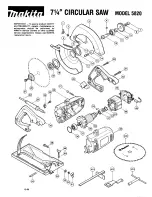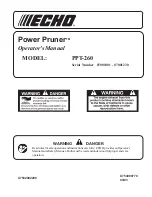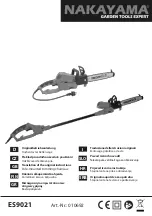
6
Safety Instructions for Table Saws
or guide the workpiece, in lieu of a rip fence or
miter gauge. Freehand sawing leads to mis-
alignment, binding and kickback.
h.
Never reach around or over a rotating saw
blade.
Reaching for a workpiece may lead to
accidental contact with the moving saw blade.
i.
Provide auxiliary workpiece support to the
rear and/or sides of the saw table for long
and/or wide workpieces to keep them level.
A long and/or wide workpiece has a tendency
to pivot on the table’s edge, causing loss of
control, saw blade binding and kickback.
j.
Feed workpiece at an even pace. Do not bend
or twist the workpiece. If jamming occurs,
turn the tool off immediately, unplug the tool
then clear the jam.
Jamming the saw blade by
the workpiece can cause kickback or stall the
motor.
k.
Do not remove pieces of cut-off material
while the saw is running.
The material may be-
come trapped between the rip fence or inside
the saw blade guard and the saw blade pulling
your fingers into the saw blade. Turn the saw
off and wait until the saw blade stops before
removing material.
l.
Use an auxiliary fence in contact with the
table top when ripping workpieces less than
2 mm (0.08 in) thick.
A thin workpiece may
wedge under the rip fence and create a kick-
back.
3. Kickback causes and related
warnings
Kickback is a sudden reaction of the workpiece
due to a pinched, jammed saw blade or mis-
aligned line of cut in the workpiece with respect
to the saw blade or when a part of the workpiece
binds between the saw blade and the rip fence
or other fixed object.
Most frequently during kickback, the workpiece
is lifted from the table by the rear portion of the
saw blade and is propelled towards the operator.
Kickback is the result of saw misuse and/or in-
correct operating procedures or conditions and
can be avoided by taking proper precautions as
given below.
a.
Never stand directly in line with the saw
blade. Always position your body on the same
side of the saw blade as the fence.
Kickback
may propel the workpiece at high velocity to-
wards anyone standing in front and in line with
the saw blade.
b.
Never reach over or in back of the saw blade
to pull or to support the workpiece.
Acciden-
tal contact with the saw blade may occur or
kickback may drag your fingers into the saw
blade.
c.
Never hold and press the workpiece that is
being cut off against the rotating saw blade.
Pressing the workpiece being cut off against
the saw blade will create a binding condition
and kickback.
d.
Align the fence to be parallel with the saw
blade.
A misaligned fence will pinch the work-
piece against the saw blade and create kickback.
e.
Use a featherboard to guide the workpiece
against the table and fence when making non-
through cuts such as rabbeting, dadoing or
resawing cuts.
A featherboard helps to control
the workpiece in the event of a kickback.
f.
Use extra caution when making a cut into
blind areas of assembled workpieces.
The
protruding saw blade may cut objects that can
cause kickback.
g.
Support large panels to minimize the risk of
saw blade pinching and kickback.
Large pan-
els tend to sag under their own weight. Sup-
port(s) must be placed under all portions of
the panel overhanging the table top.
h.
Use extra caution when cutting a workpiece
that is twisted, knotted, warped or does not
have a straight edge to guide it with a miter
gauge or along the fence.
A warped, knotted,
or twisted workpiece is unstable and causes
misalignment of the kerf with the saw blade,
binding and kickback.
i.
Never cut more than one workpiece, stacked
vertically or horizontally.
The saw blade could
pick up one or more pieces and cause kick-
back.
j.
When restarting the saw with the saw blade
in the workpiece, center the saw blade in the
kerf so that the saw teeth are not engaged in
the material.
If the saw blade binds, it may lift
up the workpiece and cause kickback when the
saw is restarted.
k.
Keep saw blades clean, sharp, and with suffi-
cient set. Never use warped saw blades or
saw blades with cracked or broken teeth.
Sharp and properly set saw blades minimize
binding, stalling and kickback. Cleaning accu-
mulated sap or plastic from the tips and body
of the blade will reduce overheating and bind-
ing of the blade. When cutting plastic materi-
als, avoid melting the plastic.
l.
Do not release the workpiece until you have
pushed it all the way past the sawblade.
Fail-
ure to do so may cause kickback and personal
injury.
SAVE THESE INSTRUCTIONS
1600A01Z1U.qxp_4100XC 10/31/19 1:21 PM Page 6







































